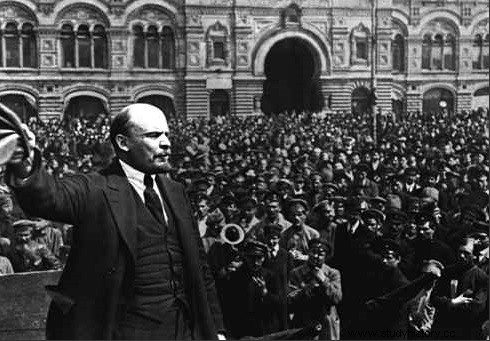 Weakened by the First World War, Russia suffered two revolutions in 1917, twelve years after that of 1905. February Revolution overthrows Tsar Nicolas II while that of October , known as the Bolshevik Revolution, pushed Russia into a new economic, political and social regime. A civil war breaks out between the new revolutionary power and the counter-revolutionaries, that is to say between the Red Army and the Tsarist White Army. The Bolsheviks establish the dictatorship of the party, which then takes the name of the Communist Party. With this party's complete takeover of a new state, the Soviet Union, the Russian revolution permanently turned its back on democracy and the West.
Weakened by the First World War, Russia suffered two revolutions in 1917, twelve years after that of 1905. February Revolution overthrows Tsar Nicolas II while that of October , known as the Bolshevik Revolution, pushed Russia into a new economic, political and social regime. A civil war breaks out between the new revolutionary power and the counter-revolutionaries, that is to say between the Red Army and the Tsarist White Army. The Bolsheviks establish the dictatorship of the party, which then takes the name of the Communist Party. With this party's complete takeover of a new state, the Soviet Union, the Russian revolution permanently turned its back on democracy and the West.
The Russian Revolution of February 1917
The First World War was a real disaster for Russia. Due to its weak industrialization and its technical backwardness, the country was not able to withstand the test of a long and modern war. At the beginning of 1917 the largely defeated Russian army was undermined by desertions, hunger and seditions. As for the people, they also suffer from precarious living conditions. Strikes and revolts are on the increase. At the head of the state, Tsar Nicholas II proves incapable of stemming the crisis or proposing satisfactory reforms. The month of February saw the beginning of a major and spontaneous movement of strikes in Petrograd (formerly Saint-Petersburg, the capital of the Russian Empire) whose slogans quickly became very radical and republican. We demand peace and bread.
At the beginning of March 1917, therefore, the first phase of the revolution began (called the "February Revolution", due to the thirteen-day shift in the Orthodox calendar then in force) . On March 8 (February 23), on the occasion of International Women's Day, strikes and demonstrations broke out in Petrograd (since 1914, the capital had changed its old name from Saint Petersburg, sounding German). The movement was initiated by the workers of the Putilov factories, but by March 9, 200,000 workers were already on strike in the capital. The extreme cold made supplies even more difficult, and the crowd demanded bread.
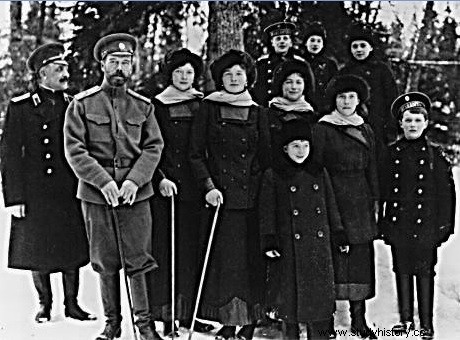 March 12 was a decisive day:the Petrograd garrison sided with the insurrection, the workers' soviet of the capital held its first session while the Duma created a Provisional Executive Committee dominated by conservative liberals (Rodzianko, Shulgin, Milioukov), but where moderate socialism was also represented by Kerensky and Trudovik. The government's decision to dissolve the Duma had no effect. Following negotiations between the Duma's Executive Committee and the Petrograd Soviet, a provisional government was created, headed by Prince Lvov (March 15). Two representatives of this government, Gutchkov and Shulgin, immediately went to Pskov, to the headquarters of the armies of the North, where the Tsar was. Nicolas II made no difficulty in abdicating (March 15, at midnight), and his brother, Grand Duke Michael, refused the throne:this marked the end of the Romanov dynasty.
March 12 was a decisive day:the Petrograd garrison sided with the insurrection, the workers' soviet of the capital held its first session while the Duma created a Provisional Executive Committee dominated by conservative liberals (Rodzianko, Shulgin, Milioukov), but where moderate socialism was also represented by Kerensky and Trudovik. The government's decision to dissolve the Duma had no effect. Following negotiations between the Duma's Executive Committee and the Petrograd Soviet, a provisional government was created, headed by Prince Lvov (March 15). Two representatives of this government, Gutchkov and Shulgin, immediately went to Pskov, to the headquarters of the armies of the North, where the Tsar was. Nicolas II made no difficulty in abdicating (March 15, at midnight), and his brother, Grand Duke Michael, refused the throne:this marked the end of the Romanov dynasty.
In Petrograd, two authorities were face to face:the Provisional Government and the Soviet of Workers and Soldiers, where the various socialist tendencies (Socialist-Revolutionaries, Mensheviks, Bolsheviks - the latter minority) were represented. They were both de facto authorities. The Provisional Government could have established democratic legitimacy by immediately organizing elections throughout Russia, but the country remained at war and the organization of such a vote faced insurmountable difficulties. This question of the war was to quickly widen the gap between the Provisional Government and the Soviet. The "February Revolution" had been greeted with sympathy by French democrats and socialists. The heads of the S.F.I.O., Jules Guesde, Marcel Sembat, Albert Thomas, had sent a cordial telegram of congratulations to Kerenski, who had become Minister of Justice (March 31). The new Foreign Minister, Miliukov, was a resolute patriot, who intended to continue the war by assigning it the traditional objectives of Russian imperialism.
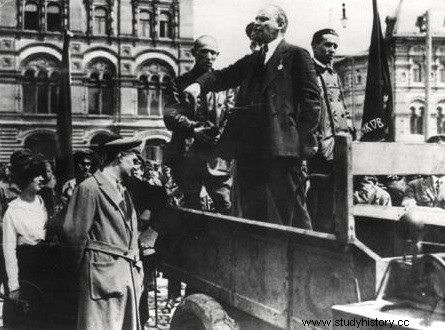 The soviet began a campaign against the Provisional Government demanding a peace without annexation or compensation, the redistribution of land to the peasants, the improvement of the lot of the working class. By Order of the Day No. 1 to the army (March 27), the Petrograd Soviet demanded the creation in all units of councils, composed of elected representatives of the soldiers, which would hold political authority, discipline traditional military which is no longer exercised except within the strict framework of hours of service. This order, which was largely carried out, evidently shattered any remaining warlike spirit in the Russian army. Under pressure from the soviet, the provisional government took various democratic measures:general amnesty, guarantee of autonomy to Finland, fixing of the working day at eight hours and abolition of the death penalty, announcement of an agrarian reform, granting of the electorate and eligibility to women.
The soviet began a campaign against the Provisional Government demanding a peace without annexation or compensation, the redistribution of land to the peasants, the improvement of the lot of the working class. By Order of the Day No. 1 to the army (March 27), the Petrograd Soviet demanded the creation in all units of councils, composed of elected representatives of the soldiers, which would hold political authority, discipline traditional military which is no longer exercised except within the strict framework of hours of service. This order, which was largely carried out, evidently shattered any remaining warlike spirit in the Russian army. Under pressure from the soviet, the provisional government took various democratic measures:general amnesty, guarantee of autonomy to Finland, fixing of the working day at eight hours and abolition of the death penalty, announcement of an agrarian reform, granting of the electorate and eligibility to women.
Lenin's Return
But the great event of this period was the arrival of Lenin in Petrograd on April 16. Having taken refuge in Switzerland since the start of the war, the Bolshevik leader returned with a group of some two hundred emigrants with the complicity of the German authorities. The very day after his return, Lenin presented the famous "April Theses" to the Bolsheviks. His great skill was to dramatize and radicalize the situation by denouncing purely and simply the Provisional Government as the expression of the imperialist bourgeoisie, the Socialist-Revolutionaries and the Mensheviks of the Soviet as the instruments of the bourgeoisie. The Bolsheviks still represented only an almost insignificant force:their influence, almost nil among the soldiers, was greater among the workers, although the mass remained with the Socialist-Revolutionaries. In March 1917, the Bolshevik Party still had only 24,000 members, including 2,000 in Petrograd and 600 in Moscow.
Breaking completely with the politicians of other tendencies, Lenin turned to the base, to the workers and soldiers of the soviets. While the provisional government was postponing the settlement of all the major internal problems until peace returned, Lenin undertook the conquest of the masses by a program which demanded everything, and immediately:All power to the soviets! Immediate peace! The land to the peasants! Control of the workers on the production and the distribution of the products! etc These “April Theses”, which the old Marxist Plekhanov called “delirium”, caused, by their extremism, a real scandal among the Mensheviks, and the Bolsheviks themselves were rather taken aback. The problem of the continuation of the war continued to divide the spirits.
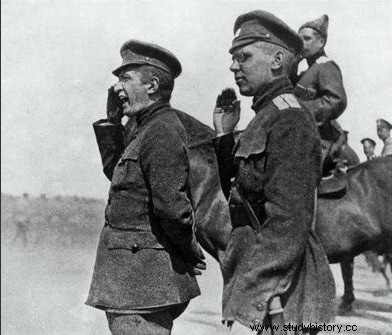 On April 22, in a declaration on its war aims, the provisional government had to solemnly renounce imperialist objectives. But Foreign Minister Miliukov, by transmitting the text of this declaration, gave the assurance to the Allies that the government would remain faithful to all the commitments entered into by tsarism. There was then, in the Petrograd Soviet, a veritable explosion of hatred against Miliukov, whose resignation was obtained by a great demonstration of workers and soldiers. Prince Lvov formed a new government with the participation of the Socialist-Revolutionary Chernov and the Menshevik Tsereteli.
On April 22, in a declaration on its war aims, the provisional government had to solemnly renounce imperialist objectives. But Foreign Minister Miliukov, by transmitting the text of this declaration, gave the assurance to the Allies that the government would remain faithful to all the commitments entered into by tsarism. There was then, in the Petrograd Soviet, a veritable explosion of hatred against Miliukov, whose resignation was obtained by a great demonstration of workers and soldiers. Prince Lvov formed a new government with the participation of the Socialist-Revolutionary Chernov and the Menshevik Tsereteli.
Becoming Minister of War, Kerensky came to the fore. While Foreign Minister Tereshchenko tried unsuccessfully to get the Allies to revise the war aims in general, Kerensky tried to restore discipline in the army. However, the Russian offensive in Galicia (July 1917) was a failure, and many units refused to fight. This unfortunate attempt aroused in Petrograd a psychosis of treason:the Provisional Government favored a campaign against the “Bolshevik plot” and accused Lenin and his friends of being agents of Germany.
On July 16-17, an uprising of armed workers and insurgent soldiers took place in the capital under the slogan:“All power to the soviets!” But Lenin judged that it was still too early to act and, at the last minute, decisive action was called off. The Provisional Government issued arrest warrants for the Bolshevik leaders (whom Trotsky had just joined), and Lenin had to go underground in Finland. The Bolsheviks, who made up only about an eighth of the delegates to the First Congress of Soviets and Workers' Deputies held in Petrograd in June/July, lost further ground.
The provisional government in turmoil
On July 20, Prince Lvov having resigned, a third provisional government was formed under the chairmanship of Kerensky. This one had to face the agitation of the national minorities (the Ukrainians had proclaimed their independence the previous month). To consolidate the regime, he convened a State Conference in Moscow, which included some 2,500 delegates, former members of the four dumas, representatives of the soviets, trade unions, professions, etc. The Bolsheviks were not represented at this conference, but they continued to carry out active propaganda in favor of immediate peace. In contrast, the moderate democrats, who wanted Russia to continue the war vigorously, pinned their hopes on the new commander-in-chief of the army, General Kornilov.
After the occupation of Riga by the Germans (September 3, 1917), the latter, judging that a military catastrophe was imminent, demanded full powers, and, as Kerensky decided his revocation, the general marched troops against Petrograd. Distraught, Kerensky called for help from the Soviet and the workers. From his retreat from Finland, Lenin ordered the Bolsheviks to lead the resistance against the military putsch at all costs. Harangued in the outskirts of Petrograd by orators from the Soviets, Kornilov's troops abandoned their leader and went to revolution.
Kerensky proclaimed the republic on September 14, but the great beneficiaries of this adventure had been the Bolsheviks, whose energy and determination had made an immense impression on the masses, and who now appeared as the only authentic defenders of the revolution. The Kornilov uprising marked the decisive turning point in the evolution started by the “February Revolution”. It gave a new impetus to Bolshevism, which now fully exploited the threat of a military coup. It showed the weakness of the provisional government. On September 13, the Petrograd Soviet sided with the Bolsheviks, and the Moscow Soviet did the same five days later.
While Kerensky savored what he saw as his triumph over Kornilov's rebellion and intoxicated with the illusion of false revolutionary solidarity against military reaction, the Bolsheviks actively preparing what was, in their eyes, the decisive part:the insurrection against the provisional government. Kerensky endeavored to give a parliamentary basis to his regime by convening a "Democratic Conference", then a Council of the Republic or "Preparliament", but the Bolsheviks, on Lenin's order, withdrew at the first session of this Preparing, after a real declaration of war on the provisional government. Trotsky, president of the Petrograd Soviet since October 6, set up a military revolutionary committee. In spite of the opposition of Kamenev and Zinoviev, Lenin, having returned clandestinely to Petrograd, had the Central Committee of the Bolshevik Party adopt the agenda on the immediate preparation of the armed insurrection on the 23rd.
The “October 1917 Revolution” in Petrograd
Preparation for the uprising took place almost in broad daylight, under the leadership of Trotsky (Lenin having returned to Finland after the Central Committee meeting). By April, the soviet had formed its own armed force, the "Red Guards", which was made up of enthusiastic but poorly trained workers. The measures of the Military Revolutionary Committee (officially created on October 25) were covered by the pretext of strengthening the defense of the capital against a military coup similar to that of Kornilov or even against a possible advance of German troops.
Kerensky completely underestimated the organizational ability of the Bolsheviks, and only at the last moment did he take protective measures. The Bolshevik agitators were able to indulge the soldiers of the Petrograd garrison in increased propaganda on the now familiar themes:"immediate peace", "land to the peasants", "all power to the soviets". From October 26, the seamen of Kronstadt were won over to them. The troops in Petrograd, who had long been in complete anarchy and feared being sent to the front by the Provisional Government, also rallied almost in their entirety on October 31.
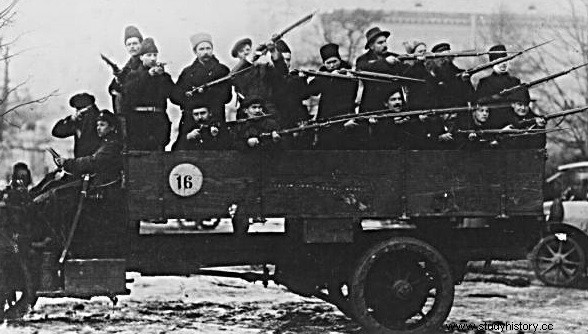 The plan of the insurrection was drawn up by a former officer, dismissed in 1905, long Menshevik and joined the Bolsheviks since the Kornilov sedition, Antonov-Ovseenko (who was to disappear in 1938 in the Stalinist purges). This plan provided, in addition to local actions carried out by the Red Guards or the soldiers rallied near their factories or their barracks, the occupation of the entire central part of the city, with the main post office, the telephone exchange, the fortress Pierre-et-Paul, the Marie and Tauride palaces and especially the Winter Palace, where the provisional government sat. On October 29, Lenin, back in Moscow, spoke at an enlarged meeting of the Central Committee, confronting his friends with this dilemma:“Either the military dictatorship of Kornilov, or the dictatorship of the proletariat. »
The plan of the insurrection was drawn up by a former officer, dismissed in 1905, long Menshevik and joined the Bolsheviks since the Kornilov sedition, Antonov-Ovseenko (who was to disappear in 1938 in the Stalinist purges). This plan provided, in addition to local actions carried out by the Red Guards or the soldiers rallied near their factories or their barracks, the occupation of the entire central part of the city, with the main post office, the telephone exchange, the fortress Pierre-et-Paul, the Marie and Tauride palaces and especially the Winter Palace, where the provisional government sat. On October 29, Lenin, back in Moscow, spoke at an enlarged meeting of the Central Committee, confronting his friends with this dilemma:“Either the military dictatorship of Kornilov, or the dictatorship of the proletariat. »
Yet Zinoviev and Kamenev continued to assert that the insurrection would lead to disaster:they even went so far as to publish a letter in a Menshevik newspaper revealing the insurrection project, but Lenin could not obtain their exclusion. Kerensky, who was beginning to get worried, then took steps that enabled the Bolsheviks to denounce an attack by counter-revolutionary forces and justify their coup before the people as an act of self-defense. At dawn on Nov. 6 (October 24), the police attempted to close the printing press of the Bolshevik organ Rabochi Put. Immediately the Military Revolutionary Committee issued a proclamation affirming that "the enemies of the people had taken the offensive", that "the counter-revolution had raised its criminal head" and that, consequently, all the forces of the soviet were mobilized. P>
The Bolsheviks seize power
The command of the uprising was at the Smolnyi Institute, a former boarding school for girls. In the afternoon, the Provisional Government placed guard posts near the many bridges of Petrograd (a city built on several islands), but the Bolsheviks, by parley or by threatening, obtained the withdrawal of all these guards and found themselves masters. bridges in the evening. The action began on the night of November 6 (October 24). For twenty-four hours already, the Arsenal and the Peter-and-Paul Fortress had been in the hands of troops rallied to the soviet, so that the latter was amply provided with arms and ammunition.
On November 7, between 2 and 5 a.m., post offices, power stations, train stations, water towers, Tavrichesky Palace, finally the telephone exchange were occupied without resistance. In the morning, the troops of the Military Revolutionary Committee were masters of the city and they brought about a disciplined calm which surprised all the foreign press correspondents. Kerensky had just left the capital to seek loyal troops from the front, but the provisional government continued to sit in the Winter Palace, defended by a small force of Cossacks, cadets and female volunteers:in all 1,300 soldiers.
Despite their numerical superiority, the Bolshevik forces did not dare to storm the Palace, which was to hold out until the following night and did not surrender at 2:10 a.m. , only after the cruiser Aurora had fired about thirty shells in its direction. The members of the provisional government were arrested. The defenders of the Winter Palace, including the women, were immediately released without violence, while the palace was sacked and the victors drank happily in the cellars of the former residence of the tsars. A few hours earlier, at the Smolnyi Institute, the Second Congress of Russian Soviets had opened. Social Revolutionaries and Mensheviks there protested against the coup that was taking place and left the room - a theatrical gesture which had no other result than to eliminate all opposition to the Bolsheviks and leave absolute power to Lenin.
The establishment of Soviet power and the peace of Brest-Litovsk
In keeping with his promise, Lenin declared that the government now belonged to the soviets. On November 8, a Council of People's Commissars was set up, composed of Lenin as President, Rykov in the Interior, Milioutin in Agriculture, Trotsky in Foreign Affairs, Lunacharsky in Public Instruction, Stalin in Nationalities, the War and the Navy being directed by a committee of three members including Antonov-Ovseenko. Lenin immediately had the Congress of Soviets adopt the two major decrees “on peace” and “on land”. The Soviet government called on all belligerent nations and their governments to open negotiations without delay for a just democratic peace, that is, without annexation and without war indemnities; he proclaimed the annulment of secret treaties and the abolition of secret diplomacy. Even more important was the decree on land, which proclaimed the immediate abolition of landed property, without compensation, the confiscation of the lands of the imperial family, churches, monasteries (November 8).
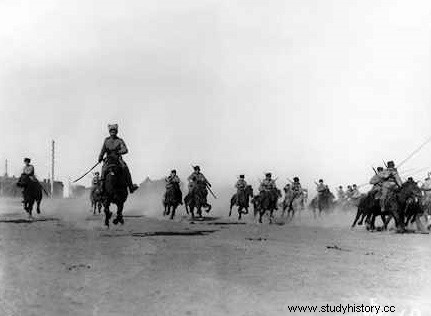 Kerensky, who had mobilized General Krasnov's Cossacks, made an attempt to retake Petrograd, but the Red Guards and the sailors of the fleet repulsed him, and he fled from Russia. At the general headquarters, the resistance was broken on November 20 and the commander-in-chief Dukhonin was massacred by the troops. At the same time, negotiations began with Germany and Austria-Hungary for the conclusion of an armistice.
Kerensky, who had mobilized General Krasnov's Cossacks, made an attempt to retake Petrograd, but the Red Guards and the sailors of the fleet repulsed him, and he fled from Russia. At the general headquarters, the resistance was broken on November 20 and the commander-in-chief Dukhonin was massacred by the troops. At the same time, negotiations began with Germany and Austria-Hungary for the conclusion of an armistice.
Within a few weeks, the Russian Empire seemed on the verge of breaking up. Finland declared its independence on December 6. Ukraine had already been de facto independent for several months, but Lenin, while loudly professing the doctrine of the right of non-Russian nationalities to self-determination, could not allow a counter-revolutionary government to be constituted in Ukraine:Ukrainian national "rada" (Assembly) he opposed a Ukrainian Bolshevik government, which established itself in Kharkov (December 1917), and Soviet troops, moving forward, seized kyiv in Feb. 1918.
In the first days of the establishment of Soviet power, the bourgeois press was banned, but Socialist-Revolutionary and Menshevik newspapers were able to continue to appear and demonstrate their opposition. However, from the end of 1917, the Bolsheviks tightened their grip on the territories they controlled:a political police or Cheka was created on December 7; on the 20th appeared a decree prohibiting the strike. The Bolsheviks, who had constantly demanded elections when they were in opposition to Kerensky, could not postpone them, because they had been decided upon, shortly before the October Revolution, by the provisional government.
Their result was extremely disappointing for Lenin, because the Bolsheviks obtained only 168 seats against 419 for the Socialist-Revolutionaries, 18 for the Mensheviks, 17 for the Constitutional-Democrats and the Right , and 81 miscellaneous. Lenin, however, did not allow himself to be discouraged:he first took advantage of the split of the Socialist-Revolutionaries, whose extreme left fraction rallied the Bolsheviks; then he affirmed that the power of the Soviets, the organ of the revolution, was superior to that of the elected Assembly. The Constituent Assembly held a single session on January 18, 1918 and, as it refused to relinquish its powers to the Soviets, it was dissolved the next day. Any legal opposition to the Bolshevik regime was henceforth impossible.
The Council of People's Commissars soon after took several important steps:creation of the Red Army, cancellation of debts and loans abroad, adoption of the Western calendar. By mid-December an armistice had been concluded at Brest-Litovsk between Soviet Russia and the Central Powers, and since then talks have been going on with a view to signing the peace treaty. Despite the opposition of Trotsky and several people's commissars, who were in favor of a "revolutionary war", Lenin maintained the need for immediate peace and the outbreak of a new German offensive on February 18, 1918 hastened the final decision. /P>
The Treaty of Brest-Litovsk (March 3, 1918) was disastrous for Russia, which lost all of Poland, Lithuania, the Baltic countries, part of Belarus, ceded Batum, Kars and Ardahan to Turkey, recognized the independence of Finland and Ukraine, thus saw itself deprived of 90% of its coal production, 70% of its metallurgy, 55% of its agricultural wealth. /P>
With the revolutions of 1917, a page turns in Russia
The work carried out for three centuries by the tsars seemed destroyed and the Russia of the soviets was now, in Europe, smaller than Muscovy at the accession of Ivan the Terrible . This peace, which allowed forty Austro-German divisions to be diverted from the eastern front and directed towards the West, was naturally regarded as a betrayal by the Allies, who would henceforth give their support to all the counter-revolutionary forces. The October Revolution had also caused a stupor in the West, where it was unanimously denounced. True to his radicalism, Lenin seemed to turn his back on the rest of the world. The transfer of the capital to Moscow (March 12, 1918) seemed, in the eyes of the West, the symbol of a regression of Russia to primitive barbarism, after the age of enlightenment opened by Peter the Great...
Bibliography
- The Russian Revolutions of 1917, by Nicolas Werth. What do I know, 2021.
- The Russian Revolutions, by Richard Pipes. Perrin, 2018.
